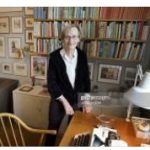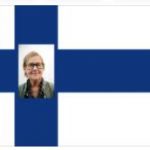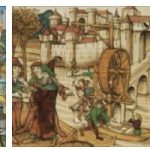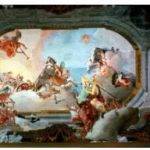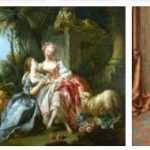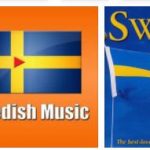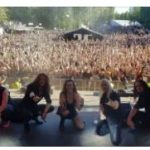Classicism
King Gustav III , a tireless patron of the arts, wrote dramas and operas, and was instrumental in founding theaters and establishing the Swedish Academy (1786). The academy and its leading members, the poets J. G. Graf Oxenstierna, J. H. Kellgren, Carl August Ehrensvärd (* 1745, † 1800) and C. G. af Leopold, as well as the idyllic Anna Maria Lenngren defended the classical French taste and the skeptical way of life against that of J. .-J. Rousseau and the German Sturm und Drang poets B. Lidner and T. Thorild. By Kellgren The published newspaper »Stockholms Posten« was the focus of public discussion; it contributed significantly to the development of literary and theater criticism in the modern sense.
Romance
The romanticism, which started late compared to the other European countries, received the decisive impetus from German idealism and the Jena romanticism. The members of the “Auroraförbundet” (“Aurorabundes”) under P. D. A. Atterbomrepresented a romantic universal poetry influenced by F. W. J. von Schelling, e. B. In Atterboms main work, “Lycksalighetens Ö” (2 volumes, 1824-27; German “Die Insel der Glückseligkeit”), in the polemical and satirical writings of Lorenzo Hammarskjöld (* 1785, † 1827) and Clas Johan Livijn (* 1781, † 1844) as well as in the novels V. F. Palmblads. The “Götische Bund” represented a national romanticism that went back to the gods of the 17th century; belonged to him inter alia. the poet and historian E. G. Geijer, A. A. Afzelius and the Swedish gymnastics father P. H. Ling. Following the example of A. von Arnims, C. Brentanos and the Brothers Grimm, Geijer and Afzelius collected folk ballads, legends and fairy tales. Outside the two camps remained the national poet of the epoch E. Tegnér, E. J. Stagnelius, who were influenced by gothicism and classicism, with his poetry influenced by Neo-Platonic mysticism, as well as the »pre-romanticists« Frans Michael Franzén (* 1772, † 1847) and J. O. Wallin.
Liberalism
After the July Revolution of 1830 in France, the ideas of European liberalism caused the romantic ideals of poetry to gradually replace poetic realism. The transition between romanticism and realism was represented by C. J. L. Almqvist, who in his main work “Törnrosens bok” (14 volumes, 1832–51) combines romantic universal poetry and realistic descriptions of everyday life. Frederik Cederborgh (* 1784, † 1835) and Carl Frederic Dahlgren (* 1791, † 1844) as well as the Finland Swedes J. L. Runeberg and Z. Topelius represented an idealistic-realistic direction. Next to Almqvist were at the establishment of a realistic romantic tradition v. a. three authors involved, who presented women’s and family problems in particular: Fredrika Bremer, Sophie von Knorring (* 1797, † 1848) and Emilie Flygare-Carlén (* 1807, † 1892). August Blanche (* 1811, † 1868) described Stockholm’s bourgeois life. From 1860 onwards, the poets of the signature group had a great influence, among others. Karl Pontus Wikner (* 1837, † 1888), C. D. af Wirsén and C. Graf Snoilsky, who together with the esthete Carl Rupert Nyblom (* 1832, † 1907) fought the advancing naturalism. Outside the literary movements stood the idealistic poet, journalist and scientist A. V. Rydberg.
Naturalism, Impressionism, Symbolism and Neo-Romanticism
According to homosociety, the 1880s (Swedish »åttitalet«) were characterized by socially critical naturalism. The dominant figure of the 1880s / 90s was A. Strindberg, who was controversial and fought throughout his life in Sweden, who introduced naturalism in Sweden with his novel “Röda rummet” (1879; German “Das Rote Zimmer”), with “Fadren” (1887; German “Der Vater”) and “Fröken Julie” (1888; German “Fräulein Julie”) created an important naturalistic drama and also had a lasting effect with later symbolist-mystical plays. Naturalism was also introduced by Strindberg’s follower G. af Geijerstam in the early 1880sand the group “Det unga Sverige” (“The young Sweden”), who took a joint realistic-radical front against the “romantic resonance” and conservatism: the poet Albert Ulrik Bååth (* 1853, † 1912), the storytellers O. J. Levertin and O. Hansson as well as the playwrights Anne Charlotte Leffler and Victoria Maria Benedictsson, as well as the Finnish-Swedish poet K. A. Tavaststjerna. Almost all of these representatives of naturalism took part in the turn towards impressionism and symbolism in the 1890s. The program of the 1890s (Swedish: “nittitalet”), which is committed to a neo-romantic aesthetic, is formulated in V. von Heidenstam’s writings “Renässans” (1889) and “Pepitas bröllop” (1890; with Levertin). Heidenstam called for an internalization of literature that leaves room for the poet’s sense of beauty and imagination. The authors of the 1890s preferred themes from Swedish history and the rural culture of the various landscapes. In the poetry of G. Fröding and E. A. Karlfeldt these motifs found their aesthetically perfect treatment. Selma Lagerlöf’s novels also reflect a neo-romantic feeling, an awareness of history and a love of home. H. Söderberg and B. H. Bergman, on the other hand, describe the fin-de-siècle mood of the Stockholm bourgeoisie; Ellen Key (* 1849, † 1926) propagated the “Century of the Child” and thus made a decisive contribution to the development of modern children’s literature.

